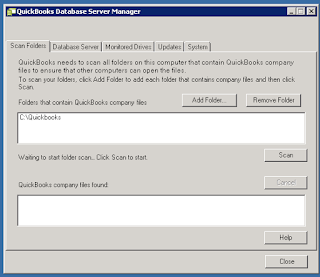HOW TO HANDLE QUICKBOOKS DATABASE ISSUES?
When QuickBooks works, the SMB accounting software is incredible; when
it doesn't work, it's an absolute nightmare. Networking issues, firewall
issues, corrupted data files, and more can quickly plague your QuickBooks
installation. Oftentimes, the errors and warnings offered by the software are
cryptic or not well documented. The next time you're unable to connect to your
QuickBooks data file, try one of the solutions outlined below for getting your
company file up and running.click here more information
Caution: You should always have a daily backup of your QuickBooks data
file. In a worst case scenario, if your file becomes corrupt, you could restore
from the previous day's backup and only lose one day's work.
CALL TOLL FREE-1-877-521-2086
How to troubleshoot data file connectivity
The QuickBooks Connection Diagnostic Tool is a small application that
will test the connection between client and database server manager and help
you to understand what is happening. In some instances, it will set the correct
firewall rules on a client machine so QuickBooks can get through to the
network.
After you install this tool, fire it up, click Browse, locate your
company data file, and click Test Connectivity. If you don't get green check
marks, you know there's an issue connecting to the database server. (The
Advanced section allows you to run IP Reverse lookups, check the DB service
status, and more.) If you are prompted to allow the diagnostic tool to open the
firewall ports, do so —the diagnostic tool is quite good at opening those
ports. If you get an error and the diagnostic cannot connect to your database
server, you'll need to work on the server.
Database server manager.
Most likely, all you have installed on your server is the QuickBooks
database server manager. With this tool, you can instruct the service where to
monitor for data files. If you do not let the QB database server know where the
data files are, those files will not be made available to clients. To make
everything a lot easier, place your data files on a shared folder on the root
of C:\\ (such as C:\\Data or C:\\QB) and make sure everyone who needs access to
the file has full rights.
Once you add the folder, click the Scan button and all data files
within that folder should appear in the QuickBooks company files found area. If
not, double check to make sure the data files are in the folder.
If your QuickBooks database server isn't running, follow these steps:
1. On your server, click Start and type services.msc in the run area.
2. In the Services window, search for the QuickBooks server manager
(QuickBooksDB20 for newer versions).
3. If older database managers are running, stop them and set them to
Disable.
4. Make sure the service is set to Automatic.
5. In the Recovery tab, make sure first, second, and subsequent
failures are set to Restart The Service and click OK
6. Right-click the service and select either Start or Restart.
7. Once the service has started (or restarted), go back to the
QuickBooks database server manager and rescan the folder.
8. When the files appear, go back to one of the clients and attempt to
connect. If you still get a connection issue, here are some troubleshooting
tips:
Make sure only the server is hosting QuickBooks. If any client machine
has hosting turned on, this can cause connection issues.
If you have not done so, copy the data file to a client machine and try
to log in to the data file. If you can, verify and rebuild the data file. Once
this is done, create a portable copy of the data file and then copy that
portable copy back to the server. Now, restore from that portable file onto a
client machine, and hopefully you'll get a connection restored.
Check your .tlg file (transaction log file) associated with your data
file. If that file is significantly larger than your data file, create a
portable copy of the data file and then restore that data file with a new name.
This will reset the .tlg file.
If you're still having trouble connecting to the data file, try very
temporarily dropping the firewall on the server and the client. If this allows
the connection through, turn the client firewall back on and try to reconnect.
If you still cannot connect, you most likely need to add exceptions in your
server firewall. Remember that once you've managed to get QuickBooks through
the firewall, bring that firewall back up on the server. For a listing of the
specific ports to let through, read this QuickBooks knowledge base article.
On occasion, the problem with the data file connection is the server.
When this happens, I move the hosting of the data file to one of the client
machines until the issue with the server is resolved. Although it's far from
ideal, this quick fix can at least get your end users working with QuickBooks
until you can find a resolution with the server. In extreme cases, I have seen
where the server was compromised, and just short of a re-install of the OS
would allow QuickBooks clients to get into the data file; these are perfect
circumstances for moving the data file to another machine. If you do this, you
have to follow through with these steps on the new host:
1. Create a shared folder on the new host.
2. Copy the data files into the shared folder.
3. Open QuickBooks on the new host.
4. Click File | Utilities | Host Multi-User Access.
Now on each client you should do the following: CLICK
HERE
1. Map the newly hosted directory on the client.
2. Open QuickBooks.
3. Open a company data file and point it to the file in the mapped
directory.
Prevention over repair
Here are some of my best tips for keeping your data file in tip-top
shape, so hopefully you won't need to fix a data file connection in the future.
Clean your data: If you click File | Utilities, you will see an entry
called Clean Up Company Data... — you should use this tool monthly or quarterly
to keep a neat and tidy data file. The clean up utility condenses closed
transactions into summary journal entries, removes unused list elements, and
creates a journal entry for each month in the selected period.Verify and
rebuild your data: The rebuild tool clears out errors (errors that are almost
inevitable with QuickBooks). You must run the tool monthly or quarterly by
going to File | Utilities, doing a verify, and then rebuilding your data file.
This will go a long way to preventing data file corruption.Log out of
QuickBooks: If you are going to be away from QuickBooks for more than 15
minutes, close the application. Why? If your machine experiences a loss of
network connectivity, and you are logged in to your data file, you can wind up
with a corrupted data file.
CLICK HERE MORE INFORMATION Quickbooks Issues- https://bit.ly/2J8gKRP





Comments
Post a Comment